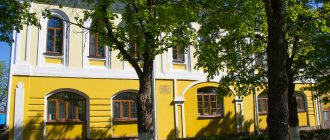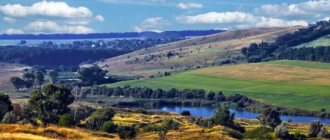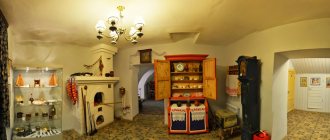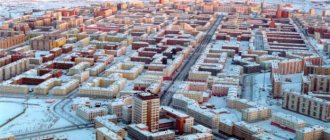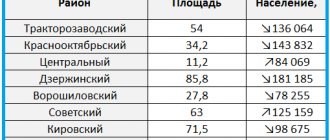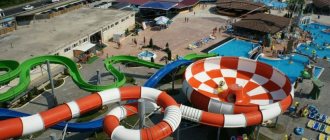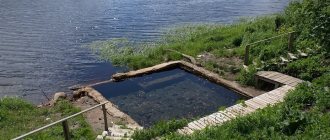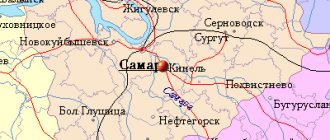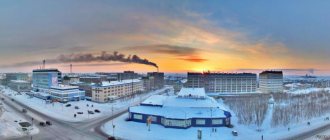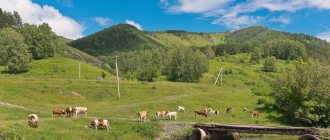We continue publications on the topic of various, mostly little-known places on planet Earth. Now we will talk about the city of Khvalynsk.
In ancient times of little memory, on the river on the Volga 500 versts above Tsaritsin there was Sosnovy Ostrov. Merchants passed there with caution, because the island, overgrown with pine forest, was chosen by robbers. The places were rich in forests and fish, and the church considered it wasteful to leave them without an owner and the monks replaced the robbers.
The settlement that arose on the island was ruled by the cellarer of the Chudov Monastery. The monastery, by the will of Vasily Shuisky, owned large areas of land and river, and the peasants caught sturgeon both for the monastic brethren and for the royal kitchen. Old Believers, archers, and other landless people flocked here.
What to see in Khvalynsk in one day
Khvalynsk is an ancient city, the settlement traces its history back to a guard outpost founded on an island in the waters of the Volga in 1556; exactly half a century later it was moved to its current location, calling it Pine Island, and in 1780 the settlement officially became the district town of Khvalynsk. At the beginning of the material, the most interesting and iconic objects that are a must-see are presented.
Khvalynsky Museum of Local Lore
- Address: st. named after K.S. Petrova-Vodkina, 40.
The main city museum of local history is considered one of the oldest cultural institutions of its kind in the Saratov region. The emergence of this attraction dates back to the end of the 19th century and is associated with the name of Mikhail Alexandrovich Radishchev.
The great-grandson of the famous writer who wrote “Journey from St. Petersburg to Moscow,” served as a judge in Khvalynsk, and was fond of ethnography, archeology, local history and natural sciences. The collections he collected formed the first exhibition, opened in 1899 in Radishchev’s house. In 1919, the private collection received the official status of a museum called natural history.
The building of the Radishchev mansion, recognized as an architectural monument, still serves as one of the museum’s exhibition grounds. The historical part is still based there, and the natural part was moved to a specially built building in 1977 on the initiative of Mikhail Suslov.
House-Museum of K.S. Petrova-Vodkina
- Address: st. Lenina, 208.
The famous painter Kuzma Sergeevich Petrov-Vodkin was born in the Saratov province and lived in Khvalynsk. Several city attractions are associated with his name. So, in 1905, the artist’s family purchased a house here.
The colorful one-story log building on a high stone foundation was built from chalk pine in 1896 and is considered a unique architectural object of the city. Today there is a memorial museum of the artist located here.
Despite the fact that Kuzma Sergeevich himself did not stay in this house for long, the created exhibition is designed to immerse you in the atmosphere in which the artist lived and worked. The building belonged to the Petrov-Vodkin family until 1943.
Khvalynsky National Park
- Coordinates on the map: 52.487260, 48.011083.
The heritage of the Khvalynsky region and its main natural attraction is considered to be a national park, spread over an area of 25.5 thousand hectares, of which 114 hectares are considered a nature protection zone. It was established in 1994 with the aim of preserving the natural, cultural and historical heritage of the region.
The flora and fauna of these lands is rich. Of the eight hundred plant species growing here, 100 are considered rare. The reserve contains different types of landscapes - mountains, hills, plains, forests.
But Khvalynsky Park is not only a protected area, a place for walks and recreation, but a real tourist Mecca, a storehouse of various attractions of a natural, historical, cultural, and religious nature. There are museums, holiday homes, and resort and recreational facilities on its territory.
Holy Cross Church
- Address: st. Dostoevsky, 10.
The creation of the provincial architect G.V. Petrov appeared in all its glory and began to receive parishioners in 1849. Officially, the Orthodox religious building is called the Temple of the Exaltation of the Precious and Life-Giving Cross of the Lord; people simply call it the Church of the Exaltation of the Cross.
Today it is one of the “calling cards” of the city, the most famous and recognizable religious landmark. The temple is built of brick and topped with gilded domes, richly decorated on the outside and decorated with paintings on the inside.
It was in this church in 1910 that the wedding of the artist Petrov-Vodkin with Maria Josephine Jovanovic, a Catholic by original religion, took place. The priest did not immediately agree to perform the ceremony. As a token of gratitude, the painter painted the “Crucifixion of Christ” painting in the temple. Unfortunately, it has now been lost.
Volga River and embankment in Khvalynsk
- Address: Khvalynskaya embankment.
In the area of the city of Khvalynsk, the Volga overflows like a sea. The current appearance of the great river and coastal zone is a consequence of the construction of the Saratov hydroelectric power station, built in the 1960s. Previously, the river here consisted of two channels, separated by an island, where there was a settlement from which Khvalynsk traces its history.
The embankment of Khvalynsk now runs along the embankment, which is also a legacy of the power plant. This is a great place for a walk where you can admire the endless expanses of the river.
House-museum of the artist K.S. Petrova-Vodkina
The artist’s parents did not have their own home, and in 1905 Kuzma Sergeevich bought them a house, which has now been turned into a museum. Petrov-Vodkin often visited his parents here and painted many famous paintings, including the painting “Bathing the Red Horse.”
The museum houses the things of the artist and his family, and the furnishings of several rooms have been completely recreated. After Petrov-Vodkin’s death during the war, his widow and daughter lived here. In 1995, after the restoration of the house and the collection of exhibits, a museum was opened here.
Location: Lenin street - 89.
Khvalynsk museums and cultural institutions
In terms of size and population, Khvalynsk is really not large - about 12 thousand people live here. However, it is still not difficult to find a place of cultural leisure and recreation here.
Art Gallery named after. Petrova-Vodkina
- Address: st. Lenina, 89.
Museum complex dedicated to K.S. Petrov-Vodkin, in addition to the memorial museum, also includes an art museum. It is also known as the Art Gallery named after the artist and is housed in a historical building that once belonged to the Radishchev family.
The exhibition of the complex consists not only of paintings by Kuzma Sergeevich; works of many masters from different eras are presented here. The collection began to take shape back in 1919 and consisted of paintings by artists of the so-called “Khvalynsky Circle”.
Petrov-Vodkin’s first work was received as a gift from the master himself in 1931; later several paintings were donated to the gallery by members of the artist’s family. Among them is one of his last works, “The Commander’s Family,” written in 1938.
Khvalynsky House of Culture
- Address: Sovetskaya st., 89A.
Petrov-Vodkin had several addresses in Khvalynsk. One of the unpreserved houses stood on the site where the building of the city Palace of Culture is located today, as evidenced by the memorial plaque. The construction of the building began at the end of the Soviet era, in 1988, but the Khvalynsky Palace of Culture was completed and put into operation only in 2004.
Today it is a venue for various events, a popular concert venue and one of the important centers of cultural life in the city. Creative groups operate there and children's sections operate there. The Palace of Culture has 8 branches in rural areas.
Museum of the vaunted apple
- Address: Sovetskaya st., 89A.
Khvalynsk is considered the apple region. An unusual exhibition, located at the Palace of Culture, is dedicated to this beloved fruit. The exhibits represent embodiments of the image of an apple in various forms of art and creativity. The tour includes interactive elements. Visitors will be offered games, master classes and, of course, will be offered to taste apples and natural juice.
Ethnographic Museum of Russian Life "Village Compound"
- GPS coordinates: 52.485827, 48.050171.
The atmosphere of the Russian village is recreated on the territory of the National Park in an open-air museum with the characteristic name “Village Compound”. Coming here, a native city dweller will be able to immerse himself in the atmosphere of rural life of past eras and see its indispensable attributes. The bulk of the exhibits date back to the turn of the 19th and 20th centuries. The exhibition has been operating since 2012.
Museum of Peasant Life "Izba"
- Coordinates: 52.486087, 48.050175.
Another museum in the National Park, housed in a log house, is dedicated to a similar theme. The decoration and exhibits inside it create the image of a typical Russian hut. The museum introduces the historical everyday life and traditions of the inhabitants of the Khvalynsky region of past eras. The exhibition presents household items - elements of costume, furniture, agricultural implements, dishes, etc.
Museum "Microworld"
- Address: Oktyabrskaya street.
Both adults and young visitors to the national park will be attracted by the interesting natural science museum. Here the tourist is introduced in an interactive form to natural processes invisible to the human eye and the tiny inhabitants of our planet, without the need to use a microscope. All exhibits are 10-15 times larger than life-size.
Bee Museum
- Address: “Sunny Glade”.
In “Solnechnaya Polyana”, on the territory of the National Park, there is a two-story house that looks like a huge beehive, with an area of 170 square meters. m. In fact, this is what he is. Inside there is an unusual museum where you can get up close and personal with the life of stinging insects that produce honey.
It’s called the “Bee Museum.” The attraction's staff will kindly tell tourists and guests about the habits of insects, the history of beekeeping and much more that is related to the topic. A curious exhibit is a bee stuck in amber, which is already 100 million years old.
Groundhog Museum
- Address: “Sunny Glade”.
On the territory of the Solnechnaya Polyana tourist complex there is a museum dedicated to the original inhabitant of the Khvalyn lands - the marmot. The steppe marmot invites tourists to visit its burrow house, larger than a man's size, in which you can learn a lot of interesting things from the life of this rodent of the squirrel family.
Alexander Medem Museum at the Orthodox Gymnasium
- Address: st. K.S. Petrova-Vodkina, 20.
Alexander Ottonovich Medem is a count who owned lands in the current Khvalynsky district, a significant historical figure for the region, a descendant of Lutherans who converted to the Orthodox faith, was subjected to repression by the Soviet regime and canonized as a great martyr.
An Orthodox gymnasium established in Khvalynsk in 2010 bears his name; on the basis of the educational institution there is a small museum telling about the difficult life of the count, about the life and culture of the era at the turn of the 19th-20th centuries, about the history of the estate that belonged to him.
Historical places: architecture of Khvalynsk
The attention of Khvalynsk tourists is also attracted by historical attractions - in particular, magnificent architecture and memorable places.
Estate "Alexandria"
- Address: st. Rabochaya, 1, pos. Northern, Khvalynsky district.
The estate of Counts Medem is located on the way from Khvalynsk to Syzran. The lands of the present village of Severny were acquired in 1874 by the parents of Alexander Medem - Otton Ludvigovich and his wife Alexandra Dmitrievna Naryshkina, in whose honor the estate was named “Alexandria”.
Much has been preserved from the estate complex. A two-story brick manor house stands on the shore of a pond. Under Alexander Ottonovich, a park was laid out around it. A steam mill, launched in 1907, is considered a landmark of the estate. This is where you get memorable photos.
House of merchant Koshcheev
- Address: Sovetskaya street, 44.
On Sovetskaya Street there is a beautiful red brick building with white decorative elements. Outwardly, it looks like a mansion; there is something fabulous in its appearance. In this little house lived a merchant with a surname similar to a folklore hero. In the sources he is called either Koshcheev or Kashcheev.
House of merchant N.S. Soldatkina
- Address: Republic Street 73a.
An elegant building with “turrets” is the creation of architect Yu.N. Terlikova is an example built in the neoclassical style in 1910. This is a residential mansion owned by merchant N.S. Soldatkin. Later, over the course of many years, new residents of Khvalynsk were born within its walls; a maternity hospital was located here.
Fire Tower
- Address: Kommunisticheskaya st., 9.
The fire tower building is considered an architectural monument and cultural heritage site of the city of Khvalynsk. The brick building dates back to 1896, and the history of firefighting in the city is much longer, part of it was first created here in 1781.
Dacha Mikhailov-Kuzmin
- Address: Russian Republic Street.
Near the banks of the Volga on the northern outskirts of Khvalynsk there is a building somewhat reminiscent of a castle. This house, interesting in its appearance, belonged to the merchants Mikhailov-Kuzmin and was used as a summer cottage. The construction dates back to 1912-1913, it is believed that its author could have been the famous architect Robert Friedrichovich Meltzer. In the Russian manner, the architect is called Roman Fedorovich.
What monuments of Khvalynsk are worth visiting for tourists?
When visiting Khvalynsk, many people think about where it is best to take a photo so that the picture reminds of the city. There are several monuments here that are definitely worth a visit.
Monument to K.S. Petrov-Vodkin
- Address: st. Lenina, 89.
In 2016, a new monument to the famous painter appeared in the city. The statue by Saratov sculptor, Honored Artist of Russia, Andrei Shcherbakov depicts Kuzma Petrov-Vodkin in full growth next to a bicycle. There is a monument near the art gallery.
Monument to those who fell in the Great Patriotic War in Victory Park
- Address: Victory Park.
A monument in memory of the soldiers of the Great Patriotic War appeared in Khvalynsk in its current location back in 1967; due to its dilapidation, it was replaced in November 1987 with the current high relief depicting soldiers. Now it is the central object of the war memorial.
Nearby there is a longitudinal rectangular stele with a memorial inscription, “covered” with a red banner. Since 2005, the Eternal Flame has been burning at the foot of the monument. The memorial is located in the park, which now bears the characteristic name “Victory Park”.
There are also other patriotic objects installed here, for example, the “Stele to fellow countrymen - heroes of the Soviet Union” and the Honor Board of the heroes of the Khvalynsky region. All of them were compactly located close to each other.
Population
| Population | ||||||
| 1856[5] | 1897[6] | 1913[5] | 1926[5] | 1931[5] | 1939[7] | 1959[8] |
| 12 900 | ↗15 127 | ↗17 300 | ↘9600 | ↗11 800 | ↗15 642 | ↗17 036 |
| 1967[5] | 1970[9] | 1979[10] | 1989[11] | 1992[5] | 2000[5] | 2001[5] |
| ↘17 000 | ↘16 249 | ↘15 572 | ↘14 948 | ↘14 900 | ↘14 800 | ↘14 700 |
| 2002[12] | 2003[5] | 2005[5] | 2006[5] | 2009[13] | 2010[14] | 2011[15] |
| ↘13 752 | ↗13 800 | ↘13 600 | →13 600 | ↘13 414 | ↘13 094 | ↘13 044 |
| 2012[16] | 2013[17] | 2014[18] | 2015[19] | 2016[3] | ||
| ↘12 947 | ↗13 005 | ↘12 985 | ↘12 814 | ↘12 788 | ||
As of January 1, 2016, in terms of population, the city was in 849th place out of 1,112[20] cities in the Russian Federation[21]
Sights of Khvalynsk related to religion
In addition to the aforementioned Church of the Exaltation of the Cross, in Khvalynsk Orthodox Christians can visit a number of churches, and there is even a mosque for Muslims.
Garden of the Temples
- Address: st. Dostoevsky, 10.
In pre-revolutionary times, in Khvalynsk, with a population of 15 thousand, there were 20 Orthodox churches. Unfortunately, many of them have not survived. The landmark created on the territory adjacent to the Holy Cross Church is dedicated to historical memory. On the initiative of the rector of the church and local historians, the lost religious buildings were recreated in miniature. Thus, the “Garden of Temples” appeared in Khvalynsk.
Skete of St. Sergius of Radonezh and the source “Holy”
- Address: Khvalynsky National Park.
The Old Believer monastery of the Trinity Metochion of the Saratov Spaso-Preobrazhensky Monastery was founded in 1903. Its first rector was the Khvalyn elder Dorotheos. Nowadays the territory of the monastery belongs to a national park. About 300 natural springs have been discovered in the park.
One of the most popular - the "Holy" spring, or Life-Giving Spring - is located near the Sergius monastery. It is believed that it was thanks to him that the place was chosen by the monks for settlement. After the dispersal of the monastery during Soviet times, the spring was abandoned, but is now landscaped and pilgrimages are made to it.
Church of St. Nicholas the Wonderworker in the village of Popovka
- Address: st. 60th anniversary of the USSR, Popovka, Khvalynsky district.
In 1909-1910, construction of a stone church began in the village of Popovka, Khvalynsky district. The brick church, topped with five domes, was designed by the architect V. Petropavlovsky. The majestic temple operated until the 30s. XX century, after which it was closed, and its premises were used for grain storage. Today he has been restored and returned to religious life.
Cathedral Mosque
- Address: st. Narovchatova, 1.
The mosque in Khvalynsk is not a remake at all. The Muslim temple is more than a century old. Its history began back in 1898; the architectural project was created by Pyotr Kuznetsov, who worked as an art teacher. It was approved, but the mosque, built in 1903, was destroyed in a fire.
In its place in 1913, a new temple was built, which has survived to this day. In Soviet times, the mosque, naturally, did not work; cultural and leisure institutions were located within its walls. In 2001, it again began to accept Muslim citizens.
Interesting Facts
- The city is mentioned in Leonid Gaidai’s comedy “Operation “Y” and other adventures of Shurik” (short story “Partner”):
Our construction and installation department has built an amount of residential space that is equal to one city like Chita, ten cities like Khvalynsk, or thirty-two Kryzhopoly.
- In 1990, the feature film “The Enchanted Wanderer” based on the story of the same name by Nikolai Leskov was shot in Khvalynsk and the surrounding area.
Natural and gastronomic attractions
Lovers of the natural beauty that Mother Nature reveals to us will appreciate the caves, springs and gardens in Khvalynsk. Gourmets will be happy to taste local honey, apples and tea.
Apple orchards
- Address: Krasnoarmeyskaya street, 200B.
It is not without reason that apples are considered one of the symbols of Khvalynsk. The city is surrounded in a semicircle by apple orchards. They have been growing here since ancient times. In the imperial era, 50 tons of fruits were sent annually from the city along the waterway for sale. Now apples continue to be cultivated, preserving and reviving the traditions of local gardening.
Beekeeping farmstead Urman
- Address: st. Saratovskaya, 17.
In addition to apples, the Khvalynsky lands are famous for the production of honey. You can learn how this delicacy is born at the active beekeeping farm - the Urman farmstead, where interesting excursions are held. Visitors will not be left without tasting and delicious tea. Arriving at the farmstead, you can also improve your health with the help of “bee therapy.”
Monk's Cave
- Coordinates: 52.432983, 48.028550.
The mysterious natural monument on the territory of the national park has been known since the century before last; the time of the appearance of the cave is not known for certain. There are many legends surrounding the object.
It is called the “Monk’s Cave” because, according to sources, the hermit Seraphim lived here. For some time, the cave was also inhabited by an old woman named Fedora; it is believed that the artist Petrov-Vodkin came here in 1914.
Chalk cliffs
- Coordinates: 52.478192, 48.061206.
The most famous natural monument and the calling card of the national park are the hills formed on the Volga upland with snow-white peaks covered with green forest caps.
They look extremely picturesque and unusual. The “Three Cones” ridge, “Kalancha” mountain and the “Tashi” ridge are especially popular. The maximum height of the peaks of the chalk mountains can reach 370 meters.
Petryaninsky spring
- Coordinates: 52.440887, 48.042163.
Of the numerous springs of the national park, along with the life-giving spring in the Sergievsky monastery, the object that was ennobled by the efforts of the local experienced forester Vladimir Petryanin gained popularity. In honor of the “creator” it is called the Petryaninsky spring.
Aviary farm "Teremok"
- Address: Oktyabrskaya st., 2B.
On the border of the national park at the entrance to the city, various animals and birds live - deer, camels, pheasants, eagles and many others. A humpbacked representative of the fauna meets young naturalists and their parents right at the entrance to Teremok. The enclosure, which was originally created as a rehabilitation center and became a mini-zoo, has a fabulous name.
Monk's Cave
Not far from Khvalynsk, near the village of Podlesnoye, there is a monk’s cave. Monks lived here in solitude. They equipped two rooms in the chalk mountain. One was intended for prayers and rest, the other for other needs. Nowadays only the outer rooms where prayers were read have been preserved. Old-timers remember stories about the last monk Seraphim, who lived in these caves and helped local residents, as he was a skilled healer. Not far from this place there is a sanatorium called “Monk’s Cave”.
Entertainment and recreation in Khvalynsk for children and adults
Thanks to its hilly terrain, the Khvalynsky region can “compete” with Austria, Finland and Belarus for the right to be a center of attraction for ski lovers.
Park-hotel "Khvalynsky" with a ski resort
- Address: Cheremshany-2 village.
One of the ski resorts is located at the Khvalynsky Park Hotel. The infrastructure here is well developed, there are trails of varying degrees of difficulty. You can go skiing, sledding or cheesecake. The park hotel also has other entertainment - billiards, an ice skating rink, and several restaurants.
Here is also one of the two popular thermal spa complexes - Cheremshanskie Terme. Inside there is a sauna, hammam, salt and massage rooms and much more. A great place to relax and improve your health. The park hotel is located in a picturesque place, in a forest.

